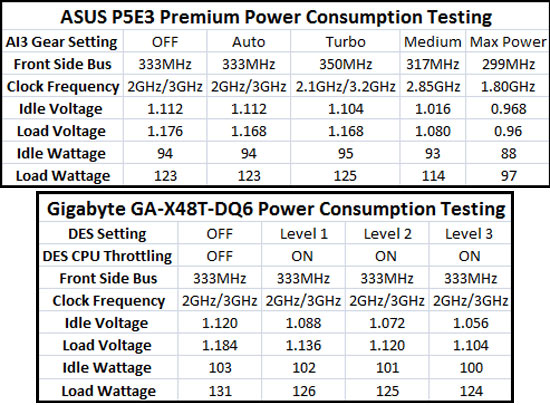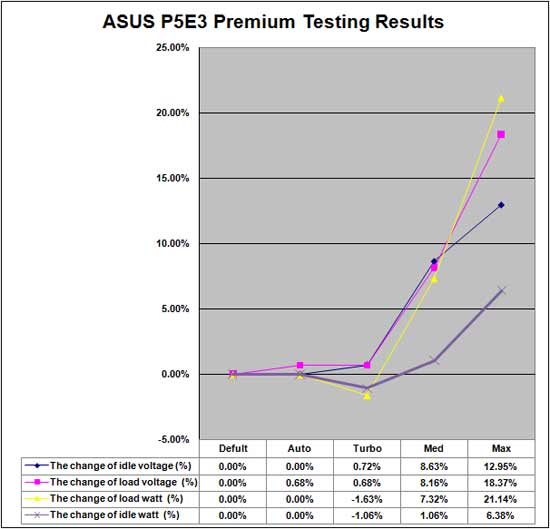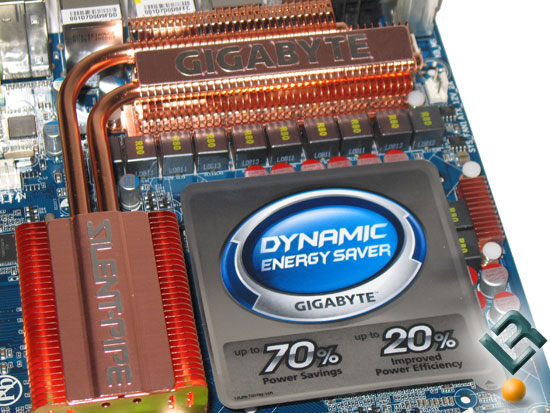Part 2: Which motherboard company is more efficient, ASUS or Gigabyte?
The Test Results

The charts above show what each power saving utility value is doing on the platform and how many Watts the entire system includes at the respective setting. I also tested each platform without the software installed and found that both systems were very different even when using all the same hardware. The Gigabyte X48T-DQ6 uses 9.6% more power at idle and 6.5% more under full CPU load than the ASUS P5E3 Premium. Since both systems have a different idle power consumption in general we can use that as the baseline for each board without the software and see the improvement that way.

The four settings in the ASUS AI Gear 3+ software do make significant difference in power savings and reduces the CPU voltage and load wattage. The ‘Auto’ mode is basically the same as not having the utility running and made no change in the power consumption at idle or load. Turbo mode is really just overclocking the system so the idle and load Watts increases. The only two settings in ASUS AI Gear 3+ that lower power consumption levels are Medium and Maximum power saving modes. Both settings decrease the FSB and ultimately the clock frequency, which lowers system peformance. The power savings are impressive though as it does reduce the idle wattage by a significant amount, which is 6.38%.

The Gigabyte DES utility has three levels of power savings through dynamic voltage levels and level three was the best setting in terms of power savings. There was a significant chance in voltages and Wattage at every setting except idle as it only saw a 2.91% improvement in power consumption at idle. The big plus to the Gigabyte DES utility is that it is fully dynamic and you get the full system power when you desire it without having to make any software changes.
Final Thoughts and Conclusions:
I was able to confirm what Jason Petermann figured out in the article published here on Legit Reviews a couple weeks ago in a review with stricter guidelines on the test system and testing procedures. The ASUS P5E3 Premium/WiFi-AP@n motherboard uses the EPU together with AI Gear 3+ to help attain the best power efficiency and energy savings we have seen to date. Even with no software enabled the ASUS board uses 9% less power at idle and 6.5% less under load, which is awesome. Is ASUS the hands down winner though? It really depends on what you are after. For a computer system that is used often the Gigabyte DES utility is superior as it is fully dynamic and you don’t sacrifice performance when you need it. The ASUS AI Gear 3+ utility lowers the CPU FSB and locks the multiplier lower, which doesn’t enable the full power of the CPU when you try to do something that require some CPU muscle. The ASUS AI Gear 3+ utility requires you to switch between power modes on a frequent basis to get the most efficiency, which gets old pretty quick. That said you have to give ASUS a big hand for being hands down the most efficient of the two with and without any software utility. Gigabyte has done a great job with their Dynamic Energy Saver software and I prefer their utility of the two, but they need to get the power levels of the board down to be able to compete on a heads up battle. Hats off to Gigabyte for sending us out another platform to make sure the testing was done correctly, but as you can see from our testing the results don’t always come out in your favor.
What I really want to know is how are companies getting the power savings numbers they are marketing with? ASUS claims that their EPU technology working together with AI Gear 3+ can help you attain energy savings up to 80.23%. Gigabyte says their proprietary hardware and software design along with Dynamic Energy Saver is able to provide power savings of up to 70% as seen on the sticker below. Im sure these are best case scenarios, but Id love to see those percentages when it comes to power savings on my personal system!


Comments are closed.